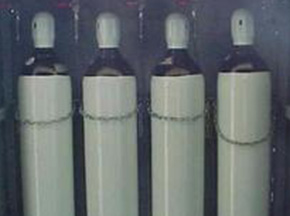
Nitrogen is an element, which exists as a gas in its natural state at normal pressure and temperature. Nitrogen makes up approximately 78% of the air we breathe. Nitrogen is an inert gas, which means that it does not react readily with other elements, and does not burn or support combustion. In the chemical and gas industries, Nitrogen is used to provide an inert atmosphere over reactive processes that would burn or explode if exposed to Oxygen in the air. Gaseous Nitrogen is colorless, odorless and tasteless
The primary hazard of gaseous Nitrogen is that it can displace the Oxygen in the air and create an Oxygen deficient atmosphere that can cause asphyxiation.
The signs of Oxygen deficiency begin to occur at 14% to 16% Oxygen in the air with an increased rate and depth of breathing. If the Oxygen content in the air falls to 4% or less, unconsciousness can occur after only one or two breaths. The Oxygen content in the air must be between 19.5% and 22.0% for personnel to enter a confined space.
Liquid Nitrogen is colorless and odorless, is lighter than water (Density 808.29 Kg /m3), and has a boiling point of -320oF (-196oC) at atmospheric pressure. It is transported and stored as a liquid for economy and convenience. One cubic foot of liquid Nitrogen will expand to 696 cubic feet of gas at the same pressure. Rapid release of nitrogen gas into an enclosed space can displace oxygen, and therefore presents an asphyxiation hazard. This may happen with few warning symptoms, since the human carotid body is a relatively slow and a poor low-oxygen (hypoxia) sensing system. Nitrogen also dissolves in the bloodstream and body fats.
As with all cryogenic liquids, exposure to the liquid or piping can cause frostbite and cold burn. This may happen almost instantly on contact, or after a second or more, depending on the form of liquid nitrogen. Bulk liquid nitrogen causes less rapid freezing than a spray of nitrogen mist (such as is used to freeze certain skin growths in the practice of dermatology).
Oxygen sensors are sometimes used as a safety precaution when working with liquid nitrogen to alert workers of gas spills into a confined space.
CATEGORY AND DETAILS
Chemical Name :- Nitrogen
Specification
IS 1747: 1972
Offered Purity
99.995%
Cylinder Colour
Grey with
Packaging
The cylinders are available in 7 m3 capacity and 150 kg/cm2 pressure, 11m3 at 200 kg/cm2 and 12 m3 at 200 kg/cm2 Portable cryogenic containers
Application
Inert properties of nitrogen make it a good “ blanketing gas ”(A gas phase introduced above a liquid or solid phase to prevent oxidation, contamination, fire, degradation, reduce hazard of detonation).Hence certain chemicals, solids, and food products are kept in a Nitrogen atmosphere.”Inerting” and “padding” are other terms used to describe displacement of air and nitrogen blanketing.
Read More